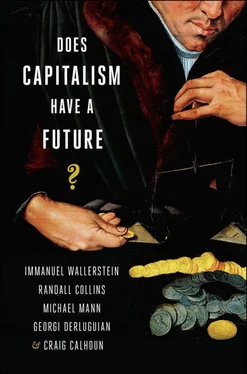Immanuel Wallerstein - Does Capitalism Have a Future?
Здесь есть возможность читать онлайн «Immanuel Wallerstein - Does Capitalism Have a Future?» весь текст электронной книги совершенно бесплатно (целиком полную версию без сокращений). В некоторых случаях можно слушать аудио, скачать через торрент в формате fb2 и присутствует краткое содержание. Город: New York, Год выпуска: 2013, ISBN: 2013, Издательство: Oxford University Press, Жанр: Публицистика, sci_economy, на английском языке. Описание произведения, (предисловие) а так же отзывы посетителей доступны на портале библиотеки ЛибКат.
- Название:Does Capitalism Have a Future?
- Автор:
- Издательство:Oxford University Press
- Жанр:
- Год:2013
- Город:New York
- ISBN:978-0-19-933084-3
- Рейтинг книги:5 / 5. Голосов: 1
-
Избранное:Добавить в избранное
- Отзывы:
-
Ваша оценка:
- 100
- 1
- 2
- 3
- 4
- 5
Does Capitalism Have a Future?: краткое содержание, описание и аннотация
Предлагаем к чтению аннотацию, описание, краткое содержание или предисловие (зависит от того, что написал сам автор книги «Does Capitalism Have a Future?»). Если вы не нашли необходимую информацию о книге — напишите в комментариях, мы постараемся отыскать её.
Does Capitalism Have a Future? — читать онлайн бесплатно полную книгу (весь текст) целиком
Ниже представлен текст книги, разбитый по страницам. Система сохранения места последней прочитанной страницы, позволяет с удобством читать онлайн бесплатно книгу «Does Capitalism Have a Future?», без необходимости каждый раз заново искать на чём Вы остановились. Поставьте закладку, и сможете в любой момент перейти на страницу, на которой закончили чтение.
Интервал:
Закладка:
The forty-year period now ending falls into roughly equal parts. The decades of the 1970s and the 1980s were marked by the crisis and collapse of the twentieth-century Left projects along with the political and economic structures of state-led national developmentalism. In the following twenty years, bracketed by the symbolic dates of 1989 and 2008, the American power found itself freed from the external pressures of the Cold War and the internal constraints of social compromises. The booming enterprise of neoconservative commentaries propagated a bullish belief in the return to capitalist normalcy while presenting it as the new, endless epoch of globalization. The post-1989 triumphalism referred in fact to the kind of normalcy experienced before the year 1914 (not the 1950s, which, although often conservative, were shaped by increasingly strong states). Back in the epoch of fledgling leftist movements and conquered non-Western peoples, capitalists could pursue their goals largely unconstrained by the demands of national governments, the considerations of social policy, and, for the first time, in a truly global arena that was unified by new transportation technologies and secured by military and political structures of colonial domination.
The prospects of twenty-first century globalization appeared to its advocates even brighter. American hegemony now kept firmly in check the imperialist rivalries of the kind that had finished off the previous globalization in 1914. The outsourcing of labor-intensive production from the core of the world economy to cheaper “emergent” locales in the periphery subverted national labor and environmental regulations and pressed governments and their citizenries to become “globally competitive.” The dismantling of government regulations allowed the leading capitalist groups to focus on reaping superprofits from the devilishly complex games of global finance. Even popular revolutions, in a paradoxical return to nineteenth-century liberalism, turned from the nemesis of capitalism into its democratic promoters in previously closed countries. The capitalist-compliant democratizations were facilitated by a spate of nongovernmental organizations enthusiastically assuming the role of latter-day global missionaries. The politically and financially cumbersome colonialism of yesteryear was replaced in the newest era of globalization by the indirect controls of powerful institutions of debt and the global network of American military bases, as well as the softer power of international advising, global mass media, and shared norms inculcated in the younger peripheral elites by acquiring prestigious diplomas in business and government administration from American universities. To this list of novel disciplining institutions, we should add illicit opportunities for money laundering through the global archipelago of microjurisdictions functioning as tax havens. The few remaining noncompliant and intransigent “rogue states” could be relegated to the Axis of Evil and serve a useful ideological function as the atrocious other.
These splendid designs ran into the structural realities of the world-system that had been profoundly transformed during the twentieth century. There could be no return to the pre-1914 imperial normalcy. Even the unprecedented concentration of military force in a single superpower in the modern age could not deliver on its geopolitical goals. In our own day the cruel coercive practices of past empires were bound to backfire. Perhaps the American jailers at the Abu Ghraib prison in Iraq stayed short of the methods of the Gestapo or, for that matter, Saddam’s own torturers. Nevertheless, these shameful images when publicized produced a storm of nationalist indignation across the Middle East and revulsion in the West. Such episodes, along with the post-1968 aversion of Western societies to casualties among their own military, put political constraints on the use of violence. Add here the sheer material costs of logistical overstretch that have not declined in the era of military high technology but have even increased; in effect, American campaigns of foreign policing became exceedingly costly and politically impossible to win.
Immanuel Wallerstein identified a different kind of constraint to American hegemony and its neoconservative globalization. Despite the persistent rhetoric of tax cuts and downsizing the government, the actual levels of taxation have remained roughly at the same historically high levels virtually everywhere. But wait, what about the stories of budget crises, cuts in public employment, shrinking pensions, and woefully underfunded education and social services? Behind this paradox we discover the reality of the continued redistribution of surpluses through state channels, official or not. Redistribution was now running in the upward direction, to people located in more powerful states and overwhelmingly to elites making political and financial decisions. The result was a huge accumulation of wealth in the hands of those who effectively became the oligarchs of our times. It is fairly simple to see how they did it. The cuts in social redistribution (in a broad sense, including policies of industrial growth and employment) freed the money still flowing through the gigantic state machineries and channeled it to the financial oligarchies. This could take the scandalous form of bailouts extended to corporations ostensibly too big to fail, yet in the main it was the endless generation of credit which in recent decades had been extensively used to cover the budget shortfalls of states and individual families.
Here comes the rub. The reason why governments and families had to be provided with ample credits is both nefarious (yes, greed and debt bondage) and clearly vital to capitalism. In the more distant past, capitalism was an elite operation catering to the fabulous consumption of higher classes and the expensive wars waged by states. In twentieth century capitalism, for the sake of large-scale market demand as well as political legitimacy, came to rely on popular mass consumption. Moreover, the twentieth-century experience of popular involvement in politics and reliance on the state set limits to how deep human misery could go without producing a disruptive backlash. This proved to be what is called the “ratchet effect” in the historical tendencies of the growing state functions in modern society.
Democratization has been a real, if not inexorable trend over the past two hundred years. This means that a great many people, including those most loyal to the existing order, came to expect three things in the course of their lives. The first is long years of education, the second is stable and reasonably rewarding employment, and, finally, pensions in older age. Housing could be added to this list of expectations, and efforts to provide housing have also been expensive. The widespread privatizations of housing in recent decades shifted financial burdens to the individual homeowners while transforming them into small capitalists who voted accordingly. But this shift inevitably led to ballooning mortgages while denying the prospect of home ownership to younger generations. The 2008 crash in the housing markets of many countries rendered this contradiction untenable.
States, on their side, needed skilled and reasonably healthy citizenry as workers, compliant taxpayers, and patriotic military recruits. In time, these historical trends would inescapably put pressure on private profits. Western capitalists responded to pressure with their own rebellion. The renewed market conservatism became its ideological platform and market globalization its main strategy. The political-economic ideology of New Right demanded that capitalists, through deregulation and government austerity, should be left to deal by their preferred means with the economic upheavals that began in the 1970s and never really abated. Globalization, first and foremost, meant the flight of large capital beyond the regulated confines of national states. Capital flight and pressures on tax revenues left the majority of governments with three unappetizing choices: printing money, going into debt, or unleashing repression by direct police brutality and slower economic suffocation. Each of the choices was fraught with its own dilemmas. Even repressing the poor, marginal, and rebellious required a lot of money to keep the loyalty of those morally consenting to repression and especially those actually doing it. But where would the governments get the money when so much of their financial flows were already committed to oligarchic interests?
Читать дальшеИнтервал:
Закладка:
Похожие книги на «Does Capitalism Have a Future?»
Представляем Вашему вниманию похожие книги на «Does Capitalism Have a Future?» списком для выбора. Мы отобрали схожую по названию и смыслу литературу в надежде предоставить читателям больше вариантов отыскать новые, интересные, ещё непрочитанные произведения.
Обсуждение, отзывы о книге «Does Capitalism Have a Future?» и просто собственные мнения читателей. Оставьте ваши комментарии, напишите, что Вы думаете о произведении, его смысле или главных героях. Укажите что конкретно понравилось, а что нет, и почему Вы так считаете.












